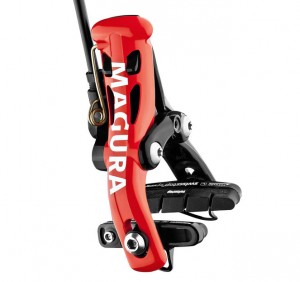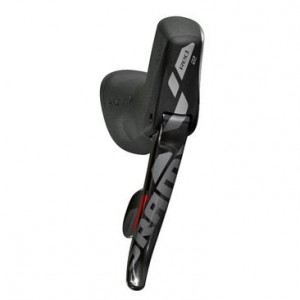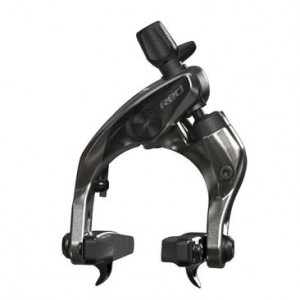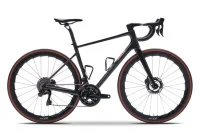Quick Review of Hydraulic Rim Brakes for the Road
by Jim Weaver, Service Manager, Fit Werx, VT
 The Cervelo P5 was a ground-breaking bike when it was introduced in the summer of 2012. As is common with many TT and tri bikes now, the rear brake caliper of the P5 is hidden behind the bottom bracket. As a general rule, hidden rear brakes are “lacking”; bottom bracket mounted brakes are often weak, with poor feel, and are frequently difficult to adjust. However, the P5 proved the exception. The first time that Bruce and I each rode a P5, one of the most stunning revelations was the brakes; these are the strongest rim brakes I have yet encountered on a TT or road bike. Why? The P5 replaces the conventional cable-actuated brake with a hydraulic rim brake caliper developed by Magura. Hydraulic brakes have distinct strength advantages over cable-actuated brakes, primarily because there is much less power loss due to complicated cable routing (the norm for aerodynamic bike frames), cable stretch, or housing flex.
The Cervelo P5 was a ground-breaking bike when it was introduced in the summer of 2012. As is common with many TT and tri bikes now, the rear brake caliper of the P5 is hidden behind the bottom bracket. As a general rule, hidden rear brakes are “lacking”; bottom bracket mounted brakes are often weak, with poor feel, and are frequently difficult to adjust. However, the P5 proved the exception. The first time that Bruce and I each rode a P5, one of the most stunning revelations was the brakes; these are the strongest rim brakes I have yet encountered on a TT or road bike. Why? The P5 replaces the conventional cable-actuated brake with a hydraulic rim brake caliper developed by Magura. Hydraulic brakes have distinct strength advantages over cable-actuated brakes, primarily because there is much less power loss due to complicated cable routing (the norm for aerodynamic bike frames), cable stretch, or housing flex.
 Ever since the introduction of the P5, I have pondered the applicability of hydraulic rim brake caliper technology to road bikes (where the shift and brake levers are integrated). I was apparently not alone as the new SRAM RED 22 component group offers the option of hydraulic rim or disc brakes (called “Hydro R” in SRAM parlance) and SRAM also has a 10 speed offering called S-700 (similar to Force). Magura also offers two models of hydraulic road brakes, the RT8C and the RT6C, and these operate in the same way as the TRP Parabox hydraulic converter. Any brake cable can be used and the cables actuate hydraulic pistons in a converter box that mounts under the stem, the rest of the system downstream is hydraulic. The result is very powerful rim brakes with very good feel and modulation. The road version of these brakes should almost equal the performance of the P5’s brakes, the only difference being a very short stretch of cable and housing that may result in some negligible loss.
Ever since the introduction of the P5, I have pondered the applicability of hydraulic rim brake caliper technology to road bikes (where the shift and brake levers are integrated). I was apparently not alone as the new SRAM RED 22 component group offers the option of hydraulic rim or disc brakes (called “Hydro R” in SRAM parlance) and SRAM also has a 10 speed offering called S-700 (similar to Force). Magura also offers two models of hydraulic road brakes, the RT8C and the RT6C, and these operate in the same way as the TRP Parabox hydraulic converter. Any brake cable can be used and the cables actuate hydraulic pistons in a converter box that mounts under the stem, the rest of the system downstream is hydraulic. The result is very powerful rim brakes with very good feel and modulation. The road version of these brakes should almost equal the performance of the P5’s brakes, the only difference being a very short stretch of cable and housing that may result in some negligible loss. 
Considerations? Well, hydraulic rim systems are approximately 200 grams heavier than the top-of-the-line cable-actuated road calipers from Campagnolo, SRAM and Shimano and the initial set-up is more complicated for those used to setting up cable systems. The systems also cost more than simple cable systems and some frames will require permanent modification (to run the rear hydraulic line inside) or will require a zip tie based retrofit to secure the lines to the frame.
Which should you consider? The Magura hydraulic rim brake systems are compatible with any cable actuated shifter. So, for those using Campagnolo and Shimano components groups or who want to retrofit an older SRAM lever without changing the shifter, the Magura hydraulic system is something to consider for significantly improved brake performance. For those with SRAM, the S-700 Hydro R will work with any existing 10 speed derailleur system and the RED 22 Hydro R will work with the latest generation of RED with 11 speed. Time will tell if hydraulic systems become the norm on road and TT/tri bikes, but the bottom line is that, whether on a rim or a disc, hydraulic brake lines dramatically improve strength and modulation of the braking system compared to traditional cable actuated brakes.









